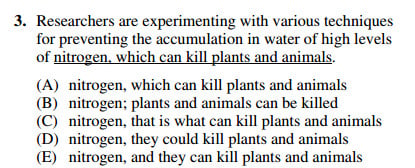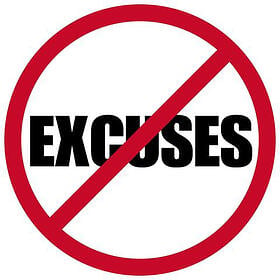
Are you struggling with SAT Writing + Reading scores between 300 and 500? You're not alone—hundreds of thousands of students are scoring in this range, too. But many don't know the best ways to break out of this score range and score 600 or higher.
Here, we'll discuss how to improve your SAT Writing score effectively, and why it's so important to do so. Put these principles to work and I'm confident you'll be able to improve your score!
UPDATE: This article discusses a previous version of the SAT. If you are looking to raise your score on the digital SAT check out my guide to getting an 600 on SAT Reading and Writing.
Brief note: This article is for students scoring below 600 on Evidence-Based Reading and Writing (EBRW). Although this score is a combination of your Reading and Writing scores, in this article, I'm focusing exclusively on Writing. So when I talk about scoring a 600 on Writing, what I really mean is getting a Writing test score of 30.
If you're already scoring above 600, my articles on how to get a perfect SAT score and how to get a perfect SAT Writing score will be more appropriate for you. You can still read this article, though, as some of it might be helpful to you. By contrast, if your goal is a 500 (or a 25 test score on Writing), these concepts will still equally apply, so I encourage you to continue reading!
In this article, I'm going to discuss why scoring high is a good idea, explain what it takes to score a 600 on SAT Writing, and then go over key test-taking strategies.
Stick with me—this is like building a house. You need to lay a good foundation before you can put up the walls and pretty windows. Here, we need to understand why you're doing what you're doing before we can dive into tips and strategies.
Getting a 600 on SAT Writing: Understand the Stakes
Improving your low SAT Writing score to something in the 600 range will dramatically boost your chances of getting into better colleges.
Let's take a popular school, Penn State University, as an example. Its average SAT score is 1270. Its 25th percentile score is 1180, and 75th percentile is 1370. Furthermore, its acceptance rate is 51%. In other words, a little more than half of all applicants are admitted. But the lower your scores, the worse your chances will be of getting in.
Based on our analysis, if you score around 1180, your chances of admission to Penn State drop to 25%, or around 1/4 chance. But if you raise your SAT score to 1370, your chances of admission go up to 75%—that's a much higher chance of admission!
For the Writing section, this is especially true if you want to apply to humanities or language programs. These programs expect your SAT Writing score to be better than your Math score. So if you score low on this section, they'll likely doubt your ability to do college-level humanities work.
As you can see, it's really worth your time to improve your SAT score. Hour for hour, it's the best thing you can do to raise your chance of getting into college.

Know That You Can Raise Your SAT Writing Score
This isn't just some lame inspirational message you see on the back of a milk carton.
I mean, literally, you and every other student can do this.
At PrepScholar, I've worked with thousands of students scoring in the lower range of 300-500.
Time after time, I see students beat themselves up over their low scores who think improving them is impossible. "I know I'm not smart." "I've just never been good at writing, and I can't see myself scoring high." "I don't know what to study to improve my score."
It breaks my heart.
Because I know that, more than anything else, your SAT score is a reflection of how hard you work and how smartly you study. Not your IQ or your school grades. Not how Ms. Anderson in 9th grade gave you a C on your essay.
Here's why: the SAT is a weird test. When you take it, don't you get the sense that the questions are nothing like what you've seen in school?
You've learned grammar before in school. You know some basic grammar rules. But the SAT questions just seem so much weirder.
The test is purposely designed this way. The SAT can't test difficult concepts because this would be unfair to students who never took AP English. It can't ask you to dissect Dostoevsky's The Brothers Karamazov. The SAT is a national test after all, which means it needs a level playing field for all students around the country.
As a result, the SAT has to test concepts that all high school students will learn. Subject-verb agreement, run-on sentences, pronoun choice, etc. You've learned all of this in school.
But the SAT still has to make the test difficult, so it tests these basic concepts in strange ways. This trips up students who don't prepare for it, but it rewards students who understand the test well.
Here's an example of an SAT Writing question, which requires you to find the grammar error in the sentence:
The commissioner, along with his 20 staff members, run a tight campaign against the incumbent.
This is a classic SAT Writing question. Try to solve it before reading on.
The error here is in the subject/verb agreement. The subject of the sentence is "commissioner," which is singular. The verb, however, is "run," but because the subject is singular, it should really be "runs."
If you didn't see an error, you fell for a classic SAT Writing trap. It purposely confused you with the interrupting phrase, "along with his 20 staff members." You're now picturing 20 people in a campaign, which suggests a plural verb!
The SAT Writing section is full of questions like this one. Nearly every grammar rule is tested in a specific way, and if you don't prepare for these, you're going to do a lot worse than you should.
Here's the good news: this might have been confusing the first time, but the next time you see a question like this, you'll know exactly what to do: find the subject and the verb, and get rid of the interrupting phrase.
Essentially, to improve your SAT Writing score, you just need to do the following:
- Study how the SAT tests these grammar rules, and learn how to detect which grammar rule you need to know for a question
I'll go into more detail about exactly how to do all of this. But first, let's see how many questions you'll need to get correct on SAT Writing to get a 600 EBRW score.
What It Takes to Get a 600 (or 30) on SAT Writing
If we have a target score in mind, it helps to understand what you need to get that score on the actual test. Remember that we're aiming for a 600 EBRW score—or, more specifically, a Writing test score of 30, out of 40.
Scoring is a little complicated for SAT Writing. Unlike the Math section, which is scored on a scale of 200-600, Writing is combined with Reading to give you a single Evidence-Based Reading and Writing (EBRW) score. In order to get this scaled score, however, your Writing and Reading scores start out as raw scores (equal to the number of questions you got right). These are converted into test scores on a scale of 10-40. Finally, the two test scores are combined and converted to a single EBRW score on a scale of 200-600.
In this sense, when we talk about getting a 600 on SAT Writing, what we really mean is getting a 30 out of 40 on SAT Writing.
Note that if you opt for the SAT Essay, this score will not be included in your SAT Writing score (it used to be before 2016; now, it's a completely separate score).
If you could use a refresher on how the SAT is scored, read our in-depth guide to SAT scoring.
Here's a raw score to SAT Writing score conversion table from an official SAT practice test. Be aware that SAT conversion tables differ for each test, so they can't offer an exact conversion—just an estimate.
| Raw |
Scaled |
Raw |
Scaled |
Raw |
Scaled |
Raw |
Scaled |
| 44 |
40 |
32 |
30 |
20 |
23 |
8 |
14 |
| 43 |
39 |
31 |
30 |
19 |
22 |
7 |
13 |
| 42 |
38 |
30 |
29 |
18 |
21 |
6 |
13 |
| 41 |
37 |
29 |
28 |
17 |
21 |
5 |
12 |
| 40 |
36 |
28 |
28 |
16 |
20 |
4 |
11 |
| 39 |
35 |
27 |
27 |
15 |
19 |
3 |
10 |
| 38 |
34 |
26 |
26 |
14 |
19 |
2 |
10 |
| 37 |
34 |
25 |
26 |
13 |
18 |
1 |
10 |
| 36 |
33 |
24 |
25 |
12 |
17 |
0 |
10 |
| 35 |
32 |
23 |
25 |
11 |
16 |
|
|
| 34 |
32 |
22 |
24 |
10 |
16 |
|
|
| 33 |
31 |
21 |
23 |
9 |
15 |
|
|
Source: Official SAT Practice Test #1
Notice that if you're aiming for a 30/40 on Writing, you need a raw score of 31-32, or around 77%. This means you need to correctly answer a bit above 3/4 of all questions.
Whatever you're scoring now, take note of the difference you need to get to a 30. For example, if you're scoring a 23, you'd need to answer 10-11 more questions right to get to a 600. Once again, if your goal is a 500 (or a 25 in Writing), the same analysis applies.
OK—so we've covered why getting a higher SAT Writing score is important, why you specifically are capable of improving your score, and the raw score you need to get to your target.
Now we'll actually get into actionable strategies that you should use in your own studying to maximize your score improvement.
How to Improve Your Low SAT Writing Score: 9 Strategies
Below, I introduce my top strategies to help you get the high SAT Writing score you deserve.
Strategy 1: Get Used to the SAT Writing Passage Format
The SAT Writing format consists of a passage on the left-hand side and questions on the right. The questions are indicated in the passage by underlines and number markers.
Take a look:

This format is a little odd to get used to since you need to alternate between reading the passage and answering questions about grammar and writing style. As some of the questions require you to understand the passage as a whole, it can get pretty tricky. And darting your head left and right to answer questions can ultimately make you lose concentration.
So in what order do you read the passage and answer the questions? We recommend this three-step strategy:
- Read every sentence to completion. If the sentence has an underline in the middle, don't stop reading the sentence. Finish reading it so you understand what it's talking about.
- Go back to the question and answer it.
- If the question has multiple questions tagged, tackle them one at a time.
We find that this strategy works best for lower-scoring students. It strikes a good balance between comprehending the passage and answering questions quickly.
Do not read the entire passage and then answer the questions. It's usually not important to comprehend the entire passage as you need to do on Reading. Most questions are very focused sentence by sentence, meaning you don't need other sentences to answer them correctly.
You can read more about tackling SAT Writing passages here.

Strategy 2: Know What's Being Tested on SAT Writing
Now that you're comfortable with the SAT passage format, it's important to know what's actually being tested on this section. You know grammar skills are being tested, but which ones? Do you know what rhetoric/style skills are being tested as well?
When you go into battle, you need to know your enemy. Here's a great breakdown at a high level of what's tested on SAT Writing.
And here's a great listing of the top 12 SAT grammar rules you should know. I won't list them here since the article I linked to is a much better explanation. For more tips on SAT grammar, check out our guide to all essential grammar rules you should know.
All these skills bring us to my next strategy ...

Strategy 3: Learn the Most Important Grammar Rules and Ignore the Others
There's just no way around it. You need to know what the most important grammar rules are and how they work in order to do well on SAT Writing.
The good news is that certain grammar rules are far more common than others on the SAT. For example, punctuation is the #1 grammar rule on the test—and almost six times more common than modifiers!
Overall, there aren't that many grammar rules you need to master. In this sense, SAT Writing is a bit easier than SAT Math, for which there are more than a dozen unique skills you need to do well.
What this means is that you can get more bang for your buck if you study correctly. Instead of reading a grammar book cover to cover, you should focus on the most critical grammar rules to improve your score most.
We dissected every official SAT practice test available to figure out how many questions will appear for every skill. Here's an overview of what we found for SAT Writing:
| SAT Writing Skill |
Questions per Test |
Grammar
|
|
| Punctuation |
4.5 |
| Sentence Structure |
3.8 |
| Conventional expression |
2.5 |
| Agreement |
2.3 |
| Possessives |
2.3 |
| Parallel structure |
2 |
| Pronouns |
1 |
| Verb Tense |
1 |
| Modifiers |
0.8 |
Rhetoric
|
|
| Sentence Function |
8.5 |
| Concision |
4 |
| Transition |
3.8 |
| Logical sequence |
2.5 |
| Precision |
2.3 |
| Quantitative |
1.5 |
| Style and tone |
1.5 |
This list isn't that useful without practice. Now that you know what to expect on SAT Writing, you need to practice the most common skills again and again. This will get you the biggest bang for your buck for every hour you spend studying.
This is how I designed our PrepScholar SAT program to work. We customize your study program to your strengths and weaknesses, forcing you to spend study time on what is really going to improve your score. You don't have to find your own SAT practice questions or decide what to study in what order—we do all of that for you!
Next strategy: find your weak links and fix them.
Strategy 4: Find Your Grammar Weaknesses and Drill Them
If you're like most students, you're better at some areas on SAT Writing than you are at others. You might know pronouns really well, for instance, but you're not very strong at sentence constructions and fragments. Or maybe you're really good at parallel construction but have no idea what a faulty modifier is.
You also don't have an unlimited amount of time to study. You have a lot of schoolwork, you might be an athlete or have intense extracurriculars, and you've got friends to hang out with. This means that for every hour you study for the SAT, it needs to be the most effective hour possible.
In concrete terms, you need to find your greatest areas of improvement and work on those.
Too many students study the "dumb" way. They just buy a prep book and read it cover to cover. When they don't improve their SAT scores, they're shocked.
I'm not.
Studying effectively for the SAT isn't like painting a house. You're not trying to cover your bases with a thin layer of understanding.
What these students did wrong was that they wasted time on subjects they already knew well—and didn't spend enough time improving their weak spots.
Studying effectively for the SAT is like plugging up the holes of a leaky boat. You need to find the biggest hole and fill it. Then you find the next biggest hole and fix that. Soon you'll find that your boat isn't sinking at all.
How does this relate to SAT Writing? You need to pinpoint the grammar rules you're having most trouble with and then do enough practice questions until they're no longer a weakness. Fixing up the biggest holes.
For every Writing question you miss, you have to identify the type of question it is and why you missed it. Once you notice patterns to the questions you miss, you can find extra practice for particular grammar rules that are difficult for you.
Say you miss a lot of questions related to commas (a very common SAT Writing mistake). You need to find a way to get lesson material to teach yourself the main concepts you're forgetting. You then need to find more practice questions for this skill so you can drill your mistakes. This is by far the best way to improve your SAT Writing score.

Learn how to eliminate answer choices systematically.
Strategy 5: Don't Pick Answer Choices Based on "Sounding Weird"—Don't Guess Randomly
The SAT tests proper English grammar very strictly. Imagine that it's a 60-year-old English professor who speaks like he came from 1850. A lot of the language on the test will sound strange to you because it's never how you would phrase sentences yourself in real life.
Here's an example:
The students for whom the scholarships were designed left the school voluntarily for health reasons.
This sentence is 100% grammatically correct. But you probably wouldn't talk like this with your friends or teachers.
Students often fall for weird-sounding language because it seems as if there must be an error. But the SAT (sneaky like it always is) knows this about you. And it designs traps for students to fall into.
Here's what you should do instead. For every wrong answer choice you eliminate, you should justify to yourself clearly why you are eliminating that answer choice.
For most grammar type questions, you're looking for the best replacement for the underlined section. Here's an example:

(Note that SAT questions only have four answer choices, but I'm just using this for illustration.)
Here's my thinking as I go through the question for the first time:
- I'm getting from this question that nitrogen can kill plants and animals, so researchers want to prevent accumulation of nitrogen. This makes logical sense to me.
- A: This sounds plausible to me. I don't see any errors. I'm keeping this answer choice as a possibility.
- B: This is strictly grammatically correct, but "plants and animals can be killed" is now in its own clause as it's been separated by the semicolon. As a result, this sentence is not communicating that nitrogen is killing plants and animals; it's just saying that "plants and animals can be killed." But by what? I'm feeling negative about this as the answer choice.
- C: This is a comma splice grammar error. "That is what can kill plants and animals" is an independent clause, and in order to join two independent clauses, I know that you need a comma and a conjunction, such as "and."
- D: This is also a comma splice error. Plus, "they" isn't the right pronoun to use. Nitrogen is singular, so you would need to use "it."
- E: This fixes the comma splice error in D since now it uses a comma and the conjunction "and." But it still has the "they" pronoun error. "They" needs to be "it" because nitrogen is singular.
- Based on all of this, I've eliminated every answer choice except A. Therefore, A is the correct answer.
I'm not literally thinking all these words in my head. I'm eliminating quickly as I read because I'm detecting the grammar errors.
It's like if I told you, "The bee fly to the hive." You'll instantly know this is wrong if you say it aloud because it feels wrong. After a few more seconds, you'd be able to point out that "bee" is singular and "fly" is plural, so we have a subject-verb agreement error.
By learning more grammar rules and practicing them, you'll be able to do this elimination more quickly and naturally. You'll pinpoint exact reasons that a phrase has a grammar error and then use that to eliminate incorrect answer choices.
This is a lot better than guessing based on things simply "sounding weird," and you'll get many more questions right with this strategy.
Strategy 6: Be Careful About Choosing NO CHANGE Too Much
On SAT Writing, most questions have a NO CHANGE option. This is the answer choice that doesn't change the underlined section and leaves the sentence as is.
The SAT loves tricking students using these answer choices because it knows that students who don't know grammar rules won't see anything wrong with the sentence. NO CHANGE is a really easy answer to choose when a question doesn't set off any grammar alarms in your ear.
But you need to be very careful whenever you choose NO CHANGE. Typically, this answer choice is correct only around 25% of the time. If you find that you're choosing NO CHANGE 40% or more of the time, you're definitely not detecting grammar errors well enough.
Every time you choose NO CHANGE, try to double-check the other answer choices to ensure you're not accidentally missing a grammar error. Also, take note of grammar rules you tend to ignore by mistake. As I mentioned in Strategy 2 above, if you study your weaknesses, you'll be able to learn which grammar rules you're weak at and need to pay special attention to.
Here's an example problem for which many students would choose NO CHANGE:

Try to solve this question.
If NO CHANGE was your first thought, try to review the other answer choices before finalizing your answer. Here's a look at what your general thought process should be:
- A: The sentence sounds OK as is—let's look at the other answers, though.
- B: "One's" lifetime—OK, so it's changing from "our" to "one's." I do know from English that I shouldn't be using "I" in my essays, so maybe this is better.
- C: "His or her"—this is similar to "one's" and it allows for multiple genders. Not sure whether this or answer choice B is better ...
- D: "Their"—wait a minute, this is different from the other answer choices because it's plural form, whereas "one's" and "his or her" are both singular. Also, what's "lifetime" referring to? It must be to "students" at the beginning of the sentence, which is plural and in the third person, so I definitely need "their" here!
- Let me review the other answer choices. Nope—they're definitely incorrect, since they are either singular or first person.
By reviewing the answer choices one last time and using Strategy 4 to eliminate choices only based on sound reasoning or grammar rules, we find that D is the right answer.
Side Note: You'll see how the same grammar rules come up over and over again—you just have to learn the patterns to do well on SAT Writing. These are the strategies we teach you in our SAT prep program so you, too, can become a grammar expert.
Finally, be especially careful about choosing NO CHANGE at the end of a question set. These are the hardest questions on Writing, and the SAT is trying extra hard to trick you by disguising the grammar rules.

Strategy 7: Don't Spend More Than 30 Seconds per Question
Of all sections, SAT Writing has the least amount of time per question. You get 35 minutes to answer 44 questions, which means only 48 seconds per question! Even worse, you have to read passages to be able to answer these questions.
If you find yourself spending more than 30 seconds on a single question, skip it for now and try to give yourself enough time to come back to it later. The most important thing is that you get all the points you can.
Having the timer end before you can get to the last question is one of the worst mistakes you can make on the SAT because it means that you weren't able to give all questions a chance. This is especially important on Writing since the questions are not arranged by order of difficulty. So you might have a really easy question at the end!
You definitely want to avoid sucking up two minutes on a single SAT Writing question. This is taking up way more time than one question deserves. You'll be better off spending all that time on other questions to get more points.
Once you've answered all the questions you can answer without spending too long on them, go back through the section and try to answer the ones you left blank. Since there is no point penalty on the SAT, it's worth it to answer every single question, even if you have to guess!
All of this requires discipline during the test, and many students ignore the clock until it's too late. Don't run out of time.
Strategy 8: Understand All Your SAT Writing Mistakes
Every mistake you make on a test happens for a reason. If you don't understand exactly why you missed a certain question, you'll make that mistake over and over again.
Too many students scoring at the 400-600 level on SAT Writing refuse to study their mistakes.
It's harsh. I get it. It sucks to stare your mistakes in the face. It's draining to learn difficult concepts you don't already understand.
So the average student will breeze past their mistakes and instead zero in on areas they're already comfortable with. It's like a warm blanket. Their thinking goes something like this: "So I'm good at subject-verb agreement? I should do more subject-verb agreement problems! They make me feel good about myself."
The result? No score improvement.
You don't want to be like these students. So here's what you need to do:
- On every SAT practice test or question set you take, mark every question you're even 20% unsure about.
- When you grade your practice test, review every question you marked and every wrong answer, even the hard ones. This way, even if you guessed a question correctly, you'll make sure to review it.
- In a notebook, write down the gist of the question, why you missed it, and what you'll do to avoid making that mistake again. I recommend organizing your notes by grammar rule (subject-verb agreement, pronoun reference, faulty modifier, etc.).
It's not enough to just think about a wrong answer and move on. It's not enough to just read the answer explanation. You have to think hard about why you failed on this specific question.
By taking this structured approach to your mistakes, you'll now have a running log of every Writing question you missed, and your reflection on why you missed it.

No excuses when it comes to your mistakes.
Strategy 9: Go Deeper—Why Did You Miss a Writing Question?
Now, what are some common reasons you might've missed a question on SAT Writing? Don't just say, "I didn't know this material." That's a cop-out.
Always take it one step further: what specifically did you miss, and what do you have to improve in the future?
Here are some examples of common reasons students miss SAT questions, and how you can take your analysis of your errors one step further:
Content: I didn't learn the knowledge or grammar rule needed to answer this question.
One step further: What specific knowledge do I need to learn, and how will I learn this skill?
Incorrect Approach: I knew the content or grammar rule, but I didn't know how to approach the question.
One step further: How do I solve this question? How will I solve questions like this in the future?
Careless Error: I misread what the question was asking for or I missed a grammar rule I already knew
One step further: Why did I misread the question? Why did I miss this grammar error? What trick did the SAT play on me? What should I do in the future to avoid this?
Get the idea? You're really digging into understanding why you're missing Writing questions.
Yes, this is hard. It's draining, and it takes work. That's why most students who study ineffectively don't improve their scores.
But you're different. Just by reading this guide, you're already proving that you care more about your SAT scores than other students do about theirs. And if you apply these principles and analyze your mistakes, you'll improve much more than other students will.
In my PrepScholar program, we force students to review every single question they miss so that each question becomes a chance to learn something new.
In Overview: How to Raise Your Low SAT Writing Score
These are the main strategies I have for you to improve your SAT Writing score. If you're scoring a 350, you can improve it to a 500. If you're scoring a 440, you can boost it to a 600. I guarantee this, as long as you put in the right amount of work and study in the ways I've suggested above.
Notice that I didn't actually teach you that many grammar rules. I didn't point out any tricks you need to know or specific grammar rules that will instantly raise your SAT score.
That's because these one-size-fits-all, guaranteed strategies don't really exist. (And anyone who tells you this is deceiving you.) Every student is different.
Instead, you need to understand where you're falling short and then drill those weaknesses continuously. You also need to be thoughtful about your mistakes and leave no mistake ignored.
This is really important for your future. Make sure to give SAT prep the attention it deserves before it's too late and you get a rejection letter you didn't want.
If you want to go back and review any of the strategies, here's a quick listing of them:
Good luck on your SAT Writing prep!
What's Next?
We have even more useful guides you can use to raise your SAT score. Learn how to improve your Math and Reading scores. Also, read our top 15 tips to improving your SAT Essay score.
What's a good SAT score for you? Read our detailed guide on figuring out your SAT target score.
Want a bunch of free SAT practice tests to practice with? Here's our comprehensive list of every free SAT practice test.
























